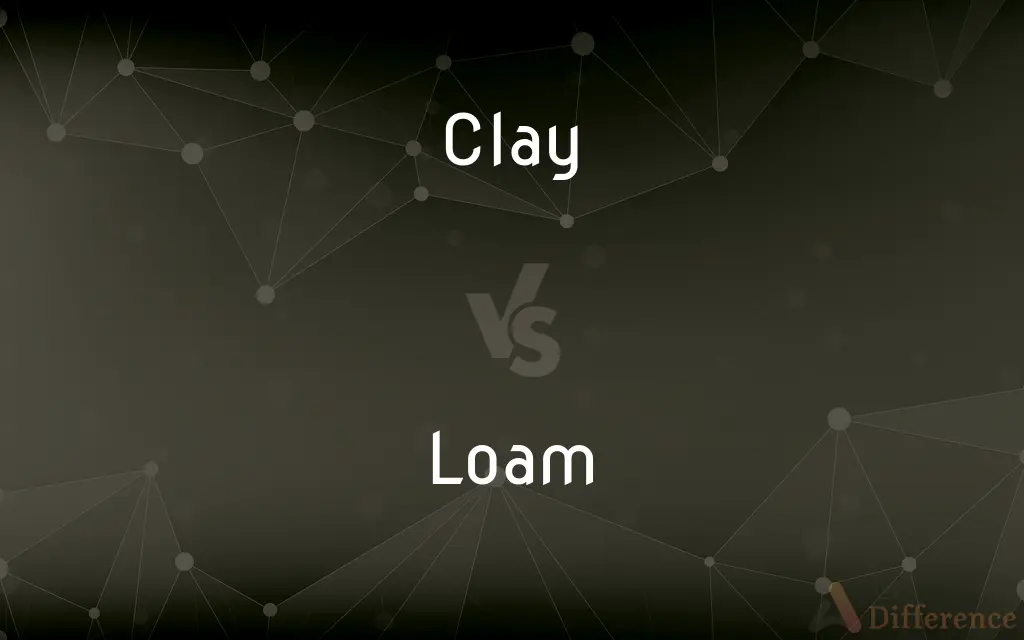Clay vs. Loam — What's the Difference?
By Maham Liaqat & Urooj Arif — Updated on April 19, 2024
Clay soil is dense with small particles and slow drainage; loam balances sand, silt, and clay, offering better drainage and nutrient retention.

Difference Between Clay and Loam
Table of Contents
ADVERTISEMENT
Key Differences
Clay soils are characterized by their very fine particles and dense structure, which can lead to slower water drainage and reduced air circulation within the soil. Whereas loam is a mixture of sand, silt, and clay that combines the best properties of each, resulting in a soil that is fertile and well-draining.
Clay tends to hold onto nutrients and water much longer because of its compact nature. On the other hand, loam facilitates easier root growth and better movement of water and nutrients due to its balanced texture.
In gardening and agriculture, clay can be challenging to work with due to its tendency to become very hard when dry and overly sticky when wet. Loam, however, is often considered the ideal garden soil because of its ability to maintain moisture and nutrient levels while still draining well.
Clay soils are more prone to waterlogging and compaction, which can stunt plant growth. Conversely, loam soils are less likely to compact, promoting healthier plant and root development.
The pH level of clay soils can vary widely, and they may require more frequent amending to correct pH imbalances. Whereas loam soils generally have a near-neutral pH, making them suitable for a wide variety of plants without the need for extensive modification.
ADVERTISEMENT
Comparison Chart
Particle Size
Very fine
Mixed (fine to medium)
Drainage
Poor
Good
Nutrient Retention
High
Moderate to high
Ease of Cultivation
Difficult
Easy
Ideal Use
Pottery, specific crops
General gardening, crops
Compare with Definitions
Clay
An artistic medium in sculpture.
The artist modeled a rough figure in clay.
Loam
Often used to describe topsoil in commercial gardening.
They ordered several cubic yards of loam for the new beds.
Clay
A natural earth material with fine particles; used in pottery and construction.
The sculptor sourced her clay from a local riverbed.
Loam
Known for its fertility and ease of use in agriculture.
Their farm thrives on the rich loam.
Clay
Soil type known for its density and moisture retention.
The garden's clay was too wet to plant in spring.
Loam
A term favored by gardeners for its versatility.
Loam supports both flowering plants and vegetables well.
Clay
A base for making bricks and tiles.
They used local clay for the bricks.
Loam
Ideal for gardening due to its balance of drainage and nutrient content.
He amended the soil to make it more like loam.
Clay
A term used in ceramics to refer to the raw material.
She teaches how to mold figures from clay.
Loam
Soil composed of sand, silt, and a smaller amount of clay.
Loam is preferred for most vegetable gardens.
Clay
Clay is a type of fine-grained natural soil material containing clay minerals. Clays develop plasticity when wet, due to a molecular film of water surrounding the clay particles, but become hard, brittle and non–plastic upon drying or firing.
Loam
The definition of Loam (in geology and soil science) is soil composed mostly of sand (particle size > 63 micrometres (0.0025 in)), silt (particle size > 2 micrometres (7.9×10−5 in)), and a smaller amount of clay (particle size < 2 micrometres (7.9×10−5 in)). By weight, its mineral composition is about 40–40–20% concentration of sand–silt–clay, respectively.
Clay
A stiff, sticky fine-grained earth that can be moulded when wet, and is dried and baked to make bricks, pottery, and ceramics
A clay soil
A clay tile
The soil is mainly clay
The rocks are covered by various mixtures of loose clays and sands
Loam
Soil composed of a mixture of sand, clay, silt, and organic matter.
Clay
A European moth with yellowish-brown wings.
Loam
A mixture of moist clay and sand, and often straw, used especially in making bricks and foundry molds.
Clay
A fine-grained, firm earthy material that is plastic when wet and hardens when heated, consisting primarily of hydrated silicates of aluminum and widely used in making bricks, tiles, and pottery.
Loam
To fill, cover, or coat with loam.
Clay
A hardening or nonhardening material having a consistency similar to clay and used for modeling.
Loam
(geology) A type of soil; an earthy mixture of sand, silt and clay, with organic matter to which its fertility is chiefly due.
Clay
(Geology) A sedimentary material with grains smaller than 0.002 millimeter in diameter.
Loam
(metalworking) A mixture of sand, clay, and other materials, used in making moulds for large castings, often without a pattern.
Clay
Moist sticky earth; mud.
Loam
To cover, smear, or fill with loam.
Clay
The human body as opposed to the spirit.
Loam
Made of loam; consisting of loam.
Clay
A mineral substance made up of small crystals of silica and alumina, that is ductile when moist; the material of pre-fired ceramics.
Loam
A kind of soil; an earthy mixture of clay and sand, with organic matter to which its fertility is chiefly due.
We wash a wall of loam; we labor in vain.
Clay
An earth material with ductile qualities.
Loam
A mixture of sand, clay, and other materials, used in making molds for large castings, often without a pattern.
Clay
(tennis) A tennis court surface made of crushed stone, brick, shale, or other unbound mineral aggregate.
The French Open is played on clay.
Loam
To cover, smear, or fill with loam.
Clay
(biblical) The material of the human body.
Loam
A rich soil consisting of a mixture of sand and clay and decaying organic materials
Clay
(geology) A particle less than 3.9 microns in diameter, following the Wentworth scale.
Clay
A clay pipe for smoking tobacco.
Clay
A clay pigeon.
We went shooting clays at the weekend.
Clay
(informal) Land or territory of a country or other political region, especially when subject to territorial claims
Danzig is rightfully German clay.
Clay
(transitive) To add clay to, to spread clay onto.
Clay
To purify using clay.
Clay
A soft earth, which is plastic, or may be molded with the hands, consisting of hydrous silicate of aluminium. It is the result of the wearing down and decomposition, in part, of rocks containing aluminous minerals, as granite. Lime, magnesia, oxide of iron, and other ingredients, are often present as impurities.
Clay
Earth in general, as representing the elementary particles of the human body; hence, the human body as formed from such particles.
I also am formed out of the clay.
The earth is covered thick with other clay,Which her own clay shall cover.
Clay
To cover or manure with clay.
Clay
To clarify by filtering through clay, as sugar.
Clay
A very fine-grained soil that is plastic when moist but hard when fired
Clay
Water soaked soil; soft wet earth
Clay
United States general who commanded United States forces in Europe from 1945 to 1949 and who oversaw the Berlin airlift (1897-1978)
Clay
United States politician responsible for the Missouri Compromise between free and slave states (1777-1852)
Clay
The dead body of a human being
Common Curiosities
Why is loam considered ideal soil?
Loam is revered for its perfect balance of particle size, drainage, and nutrient retention, making it suitable for a wide range of plants.
How can you improve clay soil?
Improving clay soil involves adding organic matter such as compost to enhance its structure and drainage.
What makes loam soil easy to work with?
Loam is crumbly and loose, facilitating easy planting, cultivating, and root penetration.
What is clay soil best used for?
Clay is excellent for crops that require more water and are tolerant of heavy soils, such as rice.
How does the water retention of loam compare to clay?
Loam retains adequate moisture without the waterlogging common in clay soils.
Is clay more fertile than loam?
Clay is very fertile due to its ability to hold nutrients, but its poor drainage can limit usability.
Can plants grow well in clay?
Some plants thrive in clay, especially those that need high moisture and nutrient levels, although many may struggle without soil amendments.
How do you identify loam soil?
Loam feels soft and crumbly, and it holds its shape when squeezed but crumbles easily when poked.
What type of plants are best suited for loam soil?
Most plants, including vegetables, flowers, and shrubs, thrive in loam due to its balanced properties.
What is the pH range typically found in loam soil?
Loam soil usually has a pH close to neutral, typically ranging from 6.0 to 7.5.
What are the disadvantages of using clay in gardening?
The main disadvantages are poor drainage, hard texture when dry, and its tendency to compact.
How do you identify clay soil?
Clay soil is sticky when wet and forms a hard solid mass when dry.
How often should loam soil be fertilized?
Loam generally requires less frequent fertilization due to its good nutrient-holding capacity.
What is the best way to manage waterlogging in clay soils?
Installing proper drainage systems and incorporating organic materials can help manage waterlogging in clay soils.
Can you convert clay into loam?
While you can't convert clay entirely into loam, adding sand and organic matter can improve its structure significantly.
Share Your Discovery

Previous Comparison
Scroll vs. Stroll
Next Comparison
Nature vs. HumanityAuthor Spotlight
Written by
Maham LiaqatCo-written by
Urooj ArifUrooj is a skilled content writer at Ask Difference, known for her exceptional ability to simplify complex topics into engaging and informative content. With a passion for research and a flair for clear, concise writing, she consistently delivers articles that resonate with our diverse audience.
















































